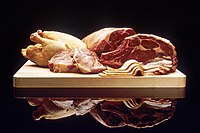
Photo from wikipedia
Type of funding sources: Foundation. Main funding source(s): British Heart Foundation Clinical Research Training Fellowship No. FS/17/81/33318 European Union’s Horizon 2020 research and innovation programme under grant agreement No 825903… Click to show full abstract
Type of funding sources: Foundation. Main funding source(s): British Heart Foundation Clinical Research Training Fellowship No. FS/17/81/33318 European Union’s Horizon 2020 research and innovation programme under grant agreement No 825903 (euCanSHare project). Multiple epidemiological studies link greater red and processed meat consumption with poorer cardiovascular outcomes. However, the impact of these exposures on directly measured cardiovascular phenotypes has not been examined in large cohorts. Limited existing studies suggest that the observed associations may be mediated by cardiometabolic diseases and/or novel mechanisms acting via the heart-gut axes. However, few studies systematically examine potential confounding and mediating mechanisms. We assessed, in the UK Biobank, the association between meat intake and cardiovascular structure and function incorporating a comprehensive range of confounders and mediators. We studied 19,408 participants with cardiovascular magnetic resonance (CMR) data. We determined average daily red and processed meat intake using food frequency questionnaires. We used oily fish as a comparator linked to favourable cardiac health. We considered conventional CMR measures (ventricular volumes, left ventricular mass, ejection fraction, stroke volume), novel CMR radiomics features (shape, texture), and arterial stiffness metrics (arterial stiffness index, aortic distensibility). Multivariable linear regression models were used to investigate associations between meat/fish intake and cardiovascular phenotypes, adjusting for age, sex, deprivation, educational level, smoking, alcohol intake, and exercise. In separate models, we investigated the mediating role of cardiometabolic morbidities. Higher intake of red and processed meat was associated with an adverse overall pattern of right and left ventricular remodelling, poorer cardiac function, and higher arterial stiffness. Conversely, higher oily fish intake was associated with a healthy cardiovascular phenotype (better ventricular function, greater arterial compliance). Radiomics analysis showed association of the different dietary habits with unique overall geometry of the ventricles and myocardial texture. These associations were partially mediated by cardiometabolic morbidities. Higher red and processed meat consumption is associated with adverse cardiovascular phenotypes. These relationships are not fully explained by mediation through cardiometabolic morbidities suggesting importance of alternative disease pathways. Understanding these potential novel disease mechanisms is important for optimising cardiovascular disease prevention strategies.
Journal Title: European Journal of Preventive Cardiology
Year Published: 2021
Link to full text (if available)
Share on Social Media: Sign Up to like & get
recommendations!